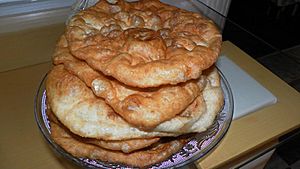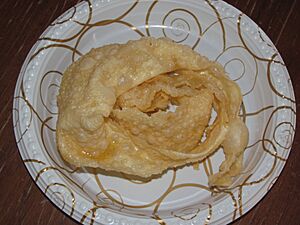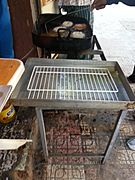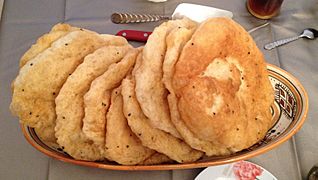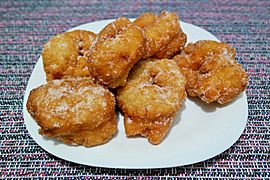Sfenj facts for kids
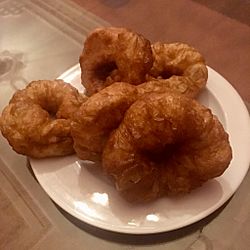
Sfenj in Marrakesh, Morocco
|
|||||||
| Alternative names | Bambalouni, khfaf, sfinz | ||||||
|---|---|---|---|---|---|---|---|
| Type | Doughnut | ||||||
| Place of origin | Maghreb | ||||||
| Main ingredients | Flour, water, sugar, yeast and salt | ||||||
| 137 kcal (574 kJ) | |||||||
|
|||||||
Sfenj (pronounced Sfenj) is a super yummy doughnut from the Maghreb region in North Africa. The name comes from an Arabic word meaning "sponge," which makes sense because sfenj is light and spongy! It's a ring of dough that gets fried in hot oil.
People often eat sfenj plain. You can also sprinkle it with sugar or soak it in sweet honey. It's a very popular treat in countries like Algeria, Morocco, Tunisia, and Libya. People usually enjoy sfenj for breakfast or in the late afternoon. It's often served with tea (like Maghrebi mint tea) or coffee.
In different places, sfenj has other names. In Tunisia, it's called bambalouni. In Libya, it's known as sfinz. In Algeria, you might hear it called Khfaf or ftayr.
Outside of North Africa, Moroccan Jews and other Sephardi Jews eat sfenj. They enjoy it especially during Hanukkah. Sfenj and other fried doughnuts are eaten then because they remind people of the Hanukkah miracle. This miracle happened when a small amount of oil, meant to light a lamp in the Temple in Jerusalem for just one day, lasted for eight days! Even though you can make sfenj at home, people in Morocco often buy it from street vendors. These vendors sometimes hang the doughnuts on palm fronds.
Contents
The History of Sfenj
Sfenj first came from a place called Al-Andalus. This was a part of Spain ruled by Muslims a long time ago. A fun story says that sfenj was made by accident. A baker supposedly dropped some dough into hot oil by mistake! Sfenj was very important in Al-Andalus. One poet even wrote, "The sfenj bakers are worth as much as kings."
We don't know exactly how sfenj spread to the Maghreb. But people say the Marinid Sultanate, who ruled Morocco from 1270 to 1465, knew about it well. Sfenj even traveled to France in the 1200s. It helped inspire a French pastry called beignets.
For a long time, sfenj was sweetened with honey or syrup. It wasn't until the 1700s that people started using sugar. This is interesting because sugarcane had been grown in the Arab world since the 700s!
Even though sfenj came from Al-Andalus, most of the bakers who made and sold it were traditionally Amazigh people. The Amazigh were nomads, meaning they traveled a lot. They, along with merchants, helped spread sfenj all over the Maghreb.
Special sfenj bakers were called sufnāj. These bakers became very important in their communities. They talked to almost every family each morning. Being a sufnāj was a respected job. In old sfenj bakeries, the sufnāj would sit on a raised platform. Customers would stand around it, raising their hands and shouting to place their orders!
Sadly, these traditional sufnājeen are becoming rare today. This is because of modern bakeries and how easy it is to find sfenj recipes online.
Sfinz in Libya
In Libya, the doughnut is called sfinz. People enjoy it sprinkled with sugar or dipped in honey or date syrup. It's a popular treat for Friday breakfast or with afternoon tea. While you can eat it all year, it's extra popular in winter. It's also a favorite during Ramadan and Eid al-Fitr holidays.
Sometimes, sfinz is made with a fried egg right in the middle! The egg can be soft or hard. People often add cheese on top too.
Sfenj in Israel
Sfenj came to Israel before 1948. Maghrebi Jews brought it with them when they moved to Mandatory Palestine. Sfenj quickly became popular for Hanukkah because it was easy to make at home.
However, sfenj's popularity for Hanukkah changed. In the late 1920s, a labor union in Israel wanted to make the jelly-filled sufganiyah the main Hanukkah food. Making sufganiyot well needs professional bakers. The union wanted to create jobs for Jewish bakers. Their plan worked! By 2016, people in Israel were eating 20 million sufganiyot each year. More Israeli Jews eat sufganiyot for Hanukkah than fast for Yom Kippur.
Different Kinds of Sfenj
Besides the regular sfenj, there are a couple of special types. These are different from just adding toppings like honey or sugar:
- Sfenj matifiyya (pronounced Sfenj mah-tee-fee-yah): This is sfenj that is flattened and then fried a second time.
- Sfenj matifiyya bil-baydh (pronounced Sfenj mah-tee-fee-yah bil-bayd): This is sfenj matifiyya with an egg added before it's fried again.
Sfenj in Sayings
Sfenj is so important in Moroccan culture that it's part of several common sayings in Moroccan Arabic:
- "Give someone a sfenj and he'll say it's ugly": This means "do not judge a book by its cover" or "don't bite the hand that feeds you." It's like someone complaining about a gift!
- "As if hitting a dog with a sfenj": This means trying to do something pointless or useless. If you hit a dog with a sfenj, the dog will just eat it and like it!
- "Demanding oil from a sufnāj": This means "taking from someone who is already in need." A sfenj baker uses a lot of cooking oil, so asking them for oil is like asking for something they barely have enough of themselves.
Gallery
-
Khfaf from Kabylie in Algeria.
See also
 In Spanish: Sfenj para niños
In Spanish: Sfenj para niños


